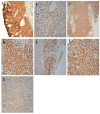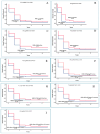The Co-Expression and Cellular Location of HER Family Members, EGFRvIII, Putative Cancer Stem Cell Biomarkers CD44 and CD109 in Patients with Glioblastoma, and Their Impacts on Prognosis
- PMID: 40227788
- PMCID: PMC11987930
- DOI: 10.3390/cancers17071221
The Co-Expression and Cellular Location of HER Family Members, EGFRvIII, Putative Cancer Stem Cell Biomarkers CD44 and CD109 in Patients with Glioblastoma, and Their Impacts on Prognosis
Abstract
Background/objectives: The aberrant expression and activation of HER family members is a known major oncogenic pathway for the proliferation, progression, and metastasis of a wide range of human malignancies. In this study, our aim was to examine the relative expression and prognostic significance of all members of the HER family, the type III EGFR mutant (EGFRvIII), and the putative stem cell markers CD44 and CD109 in patients with glioblastoma.
Methods: The expression levels of wild-type EGFR (wtEGFR), HER2, HER3, HER4, EGFRvIII, CD44, and CD109 were determined in tumour specimens from 80 patients by immunohistochemistry. The staining was scored based on the percentage of positive tumour cells, the intensity, and the cellular location of immunostaining. The association between the expression level of the biomarkers and patient overall survival was evaluated using Chi-squared, Kaplan-Meier survival curves, and log-rank tests.
Results: At a cut-off value of ≥5% with positive staining, 46% (wtEGFR), 75% (HER2), 19% (HER3), 71% (HER4), 85% (EGFRvIII), 95% (CD44), and 16% (CD109) of the cases were positive for these biomarkers. Interestingly, at the same cut-off value, the expression of wtEGFR in these patients was accompanied by co-expression with HER2 (35%), HER3 (0%), HER4 (30%), EGFRvIII (36%), CD44 (44%), HER2/EGFRvIII (28%), HER2/CD44 (31%), and EGFRvIII/CD44 (36%). In addition, the expression of EGFRvIII was accompanied by co-expression with HER2 (65%), HER3 (15%), HER4 (63%), CD44 (83%), CD109 (16%), wtEGFR/HER2 (28%), and 55% of the cases had co-expression of EGFRvIII/HER2/HER4/CD44. With the exception of HER2 expression, at cut-off values of ≥5% of tumour cells with positive staining, which was associated with better overall survival [HR = 0.57 (p = 0.038), HR = 0.56 (p = 0.034)], there was no significant association between the expression of other members of the HER family, EGFRvIII, CD44, and CD109 on the overall survival in both univariate and multivariate analysis. Conclusions Our results suggest that the co-expression of different members of the HER family, with EGFRvIII, CD44, and CD109, occurs in patients with glioblastoma. As the results of therapy with EGFR inhibitors have not been encouraging in patients with a brain tumour, further investigation should determine whether the co-expression of such biomarkers can be of predictive value for the response to the therapy with various types of HER inhibitors and their potential as therapeutic targets for co-targeted therapy.
Keywords: CD109; CD44; EGFRvIII; Glioblastoma; HER2; HER3; HER4; prognosis; wtEGFR.
Conflict of interest statement
The authors declare that they have no competing interests.
Figures


References
Grants and funding
LinkOut - more resources
Full Text Sources
Research Materials
Miscellaneous

